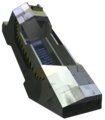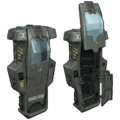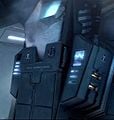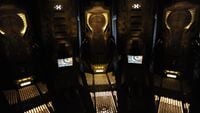Cryo chamber: Difference between revisions
From Halopedia, the Halo wiki
Lord Susto (talk | contribs) |
Sith Venator (talk | contribs) |
||
| Line 46: | Line 46: | ||
*''[[Halo: The Fall of Reach]]'' {{1st}} | *''[[Halo: The Fall of Reach]]'' {{1st}} | ||
*''[[Halo: Combat Evolved]]'' | *''[[Halo: Combat Evolved]]'' | ||
*''[[Halo: The Flood]]'' | *''[[Halo: The Flood]]'' | ||
*''[[Halo: First Strike]]'' | *''[[Halo: First Strike]]'' | ||
| Line 64: | Line 63: | ||
**''[[Halo: Fall of Reach - Boot Camp|Boot Camp]]'' | **''[[Halo: Fall of Reach - Boot Camp|Boot Camp]]'' | ||
**''[[Halo: Fall of Reach - Invasion|Invasion]]'' | **''[[Halo: Fall of Reach - Invasion|Invasion]]'' | ||
*''[[Halo: Combat Evolved Anniversary]]'' | |||
*''[[Halo 4: Forward Unto Dawn]]'' | *''[[Halo 4: Forward Unto Dawn]]'' | ||
*''[[Halo 4]]'' | *''[[Halo 4]]'' | ||
Revision as of 04:23, May 28, 2014
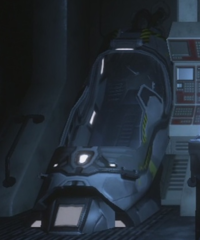
A cryo-chamber is plastasteel pod with a form-fitting gel bed that allows all of a starship's non-essential personnel to be cryonically frozen for long periods of time, most commonly during prolonged Slipspace jumps.[1] An example of this is John-117, who was stored in a cryo-chamber aboard the ship UNSC Pillar of Autumn and later unhatched from the cryosleep chamber by Tech Chief Thom Shephard along with Tech Officer Sam Marcus.
Known models of the cryo-chamber include the Mark VII Personal Suspension Unit, manufactured by Jakubaitis Standard Systems. It was widely disliked by UNSC personnel because of its inferior moisture balancing; this resulted in dry, itchy skin for a day or more after awakening, known as "cryo-itch". It was later replaced by the Mark VIII Cryogenic Suspension Chamber, although many older craft still use the Mark VII.[2]
Technical specifications
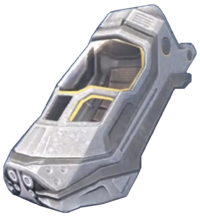
The cryo-chambers are usually stored in a dedicated area of of the ship, commonly referred to as a "cryo bay".[3] Cryo chambers are monitored by the ship's AI, and the AI can awaken crew members at a moment's notice. Cryo-computer is designed to change the pharmaceuticals dosage if a individual appears as though they might wake from cryogenic sleep.[4] Cryo wake-up protocols demand that crew check each other to make sure everyone revives from cryo all right. There is usually a medical pod in cryogenics bays for emergency resuscitation situations.
To prevent ice crystals from forming in one's cells, a person going into cryo-sleep must be injected with a chemical known as cytoprethaline.[5] A substance known as bronchial surfactant must also be ingested to protect the lungs. Individuals in cryo tubes are given a steady supply of pharmaceuticals that control the frequency and duration of cryo-sleep cycles along with influencing the content of their dreams.[6] While in cryo, humans do not age. Often a person may be placed in cryo in order to save them from succumbing to grievous injuries, such as in the case of Linda-058, who was placed in a cryo-chamber after being severely injured during the Fall of Reach, and successfully revived later despite being previously declared clinically dead.
People are almost always stored in cryo-pods naked, as covered skin generally reacts badly to the cryo process, leaving skin raw and blistered.[7] However, it is possible for Spartans to go into cryo-chambers fully armored, using their conditioning and training to ignore the pain.[8] Cadets at Corbulo Academy regularly wore carbon-black skintight clothing during cryo training; the use of these "cryo suits" did not lead to the blistering frequently caused by normal clothing. As of the year 2557, UNSC personnel on at least some ships are given special white jumpsuits to wear when going into cryo.[5]
Entering cryo can also be used as an emergency measure. Each chamber will hold an individual for as long as necessary, and can be ejected prior to an emergency landing, thus saving some crew from harm to be recovered later. Some pods feature slow-impulse thrusters for limited maneuvering in the event of ejection.[9] After the aft section of the UNSC Forward Unto Dawn is left drifting in space possibly years from rescue, the Master Chief entered cryo sleep in order to survive the wait for rescue.
Trivia
- Cryo-chambers are referred to as "the freezer" in slang,[10] named after a term often called freezer burn which is a pain in joints and muscles caused by the cryo sleep pharmaceuticals trapped in muscles and joints. Another slang term for the chamber is "the Admiral's wife" because it is a "frosty bed."[11] Being put in cryo is also referred to as being "put on ice."[12]
- The slipspace field pod is the Forerunner equivalent to the cryo chamber; these pods use a slipspace stasis field to suspend the occupant in time and to protect them from outside harm. It is unknown whether the Covenant possesses an equivalent of the cryo chamber, as such technology is yet to be mentioned or observed.
- Even though humans must enter a cryo-tube naked or risk being blistered when they emerge, Professor Ellen Anders in Halo Wars and Dr. Catherine Halsey in The Package both entered their tubes fully clothed. These were cases of artistic license, however, since showing nudity would force up both the game's and the short film's rating.
- In Halo: Combat Evolved, it is possible through a glitch to get back inside the tube, and see the Chief, headless.
Gallery
A cryo-chamber in Halo: Combat Evolved.
John-117 in a cryo-chamber in Halo: Combat Evolved Anniversary.
- Cryo01.jpg
Cryo-chambers aboard UNSC Spirit of Fire, as seen in Halo Wars.
A marine inside a cryo-chamber.
Catherine Halsey in a cryo-chamber, fully clothed.
- DawnCryoConcept.jpg
Concept art of the cryo-bay on the Forward Unto Dawn.
Cortana giving the command to thaw the Master Chief.
List of appearances
- Halo: The Fall of Reach (First appearance)
- Halo: Combat Evolved
- Halo: The Flood
- Halo: First Strike
- Halo: Contact Harvest
- Halo 3
- Halo: The Cole Protocol
- Halo Wars
- Halo Legends
- Halo: Evolutions - Essential Tales of the Halo Universe
- Halo: Blood Line
- Halo: Reach
- Halo: Fall of Reach
- Halo: Combat Evolved Anniversary
- Halo 4: Forward Unto Dawn
- Halo 4
- Halo: Escalation
Sources
- ^ Halo: First Strike, page 150 ("John brushed off the frost buildup that clouded the top half of the cryotube, and revealed the green-armored figure sprawled behind the plastasteel shell.")
- ^ Halo Encyclopedia, page 216
- ^ Halo: Combat Evolved, campaign level The Pillar of Autumn
- ^ Halo: Contact Harvest, page 60 ("The cryo-computer observed a surge of activity in Avery’s brain-an effort to yank himself out of REM-and upped his dosage.")
- ^ a b Halo 4: Forward Unto Dawn
- ^ Halo: Contact Harvest, page 60
- ^ Halo: The Flood, page 20
- ^ Halo: The Flood, page 21
- ^ Halo: First Strike (2010), Adjunct
- ^ Halo: The Fall of Reach, page 102
- ^ Halo: The Cole Protocol, page 21
- ^ Halo: The Cole Protocol, page 21

